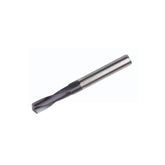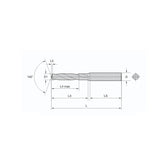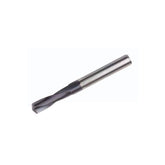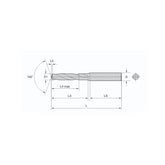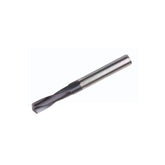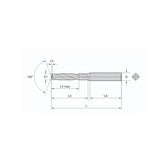As a Tool Engineer, You Must Know How to Choose a Milling Cutter!
High-Hardness End Mill Selection Guide
What specific parameters need to be considered when selecting high-hardness end mills? What are the more general factors to consider?

Currently, various companies are increasingly using high-toughness materials in their production processes. To adapt to the high-speed machining of high-hardness materials, higher standards are being set for the service life and machining efficiency of high-hardness end mills.
1. Material Considerations

When machining high-hardness materials, some effective strategies to improve tool machining efficiency include:
- Selecting the appropriate tool material
- Determining reasonable tool geometric parameters
- Optimizing and upgrading tool structure
- Selecting suitable machining processes

When the fixture is clamped, high-hardness end mills can cut mold steel, cast iron, stainless steel, and other steels with a hardness of about HRC30. It is designed to process:
- Quenched steel with hardness up to 30-50 HRC
- Tempered steel with HB250-400
- Materials that ordinary end mills cannot handle, such as stainless steel
Common high-hardness materials include:
- Chilled cast iron
- Quenched steel
- Powder metallurgy materials
- Other special materials
Properties of High-Hardness Materials:
These materials are characterized by high hardness (usually greater than HRC45, but some can reach HRC68), high strength, and low plasticity. The tool tip has a high risk of fracture and will eventually wear out.
Tool Requirements:
To correctly machine high-hardness materials, the tool must possess:
- Excellent high-temperature hardness and resistance to plastic deformation
- Outstanding chemical stability (no thermal degradation or chemical reactions)
- High thermal conductivity to prevent damage from thermal shock
2. Types of End Mills
Common high-hardness end mills mainly consist of three types:
1) Flat End Mills

Flat end mills can cleanly cut a variety of materials including copper, cast iron, carbon steel, stainless steel, tool steel, titanium alloy, and heat-treated steel.
They feature:
- Excellent finished surface roughness
- Heat-resistant ALTIN coating for high-speed machining
- High toughness due to fine-grained carbide construction
2) Ball End Mills

Ball end mills possess high hardness, wear resistance, and anti-adhesion properties. They are commonly used for engraving, cutting, and carving.
Key features:
- Tungsten carbide construction for high wear resistance
- Double-edged cutting blade for clean and accurate cuts
- Versatility for cutting various materials including wood and non-ferrous metals
3) Corner Radius End Mills (Round Nose Mills)

Corner radius end mills are primarily used as roughing tools. They can be used for milling flat surfaces and are effective for cutting curves or milling side walls.
Characteristics include:
- Large chip flutes for efficient chip removal
- High hardness and wear resistance
- Nano-coating to prevent chemical reactions and wear
- Ability to perform high-speed roughing to finishing on heat-treated materials
3. Coatings

TiN - Titanium Nitride
Basic universal wear-resistant coating for high-hardness end mills. TiN is wear-resistant and corrosion-resistant. It reduces material adhesion, improves chemical and temperature stability, and reduces friction.
TiCN - Titanium Carbonitride
Anti-adhesion, corrosion-resistant, wear-resistant coating. TiCN is more impact-resistant and harder than TiN. It can extend tool life by up to 8 times depending on application parameters.
AlTiN - Aluminum Titanium Nitride

Provides excellent protection against heat and oxidation. Tools coated with AlTiN can have a service life up to 14 times longer than uncoated tools. Withstands temperatures up to 900°C.
TiAlN - Titanium Aluminum Nitride

Offers excellent wear resistance along with strong resistance to thermal stress and oxidation. The addition of aluminum increases heat resistance by 100°C compared to standard TiN coating.
4. Selection Guidelines

High-hardness milling cutters should be selected based on:
Workpiece Hardness:
- For hardness below HRC40 (e.g., carbon steel): TiN coating
- For hardness around HRC50 (e.g., alloy steel, tool steel): TiAlN coating
- For higher hardness: Specialized tool forms, carbide materials, and coatings
Workpiece Contour:
Ball end mills come in three neck variations: standard, long neck, and tapered neck. The choice depends on cutting depth and workpiece shape. Tapered neck end mills offer higher rigidity and improved machining accuracy.
Machining Precision:
Standard ball end mills have arc accuracy less than 10μm, while high-precision versions offer 0.5 to 5.0μm accuracy for high-precision machining.
Cooling Considerations:
For materials like chilled cast iron, using compressed air for cooling is often better than cutting fluid, as it maintains consistent temperature and helps remove chips from the cutting area.
Tool Rigidity:
The cutting edge should be as short as possible for maximum rigidity. If the blade length is doubled, tool body rigidity decreases to 1/8 of its original value.
5. Conclusion
High-hardness end mills are excellent tools for improving productivity. They can process a wide range of materials that ordinary end mills cannot handle, including stainless steel, quenched steel (30-50 HRC), and tempered steel (HB250-400).
Proper selection based on material properties, tool type, coating, and application requirements is essential for achieving optimal machining results with high-hardness end mills.
